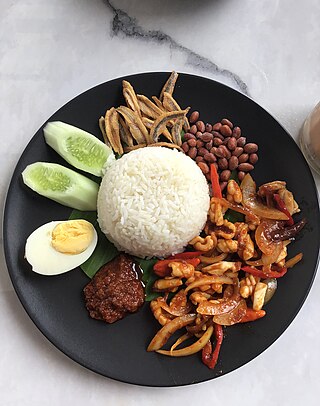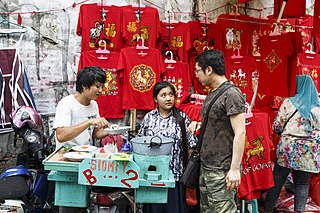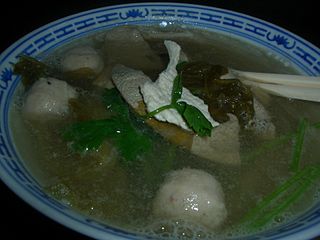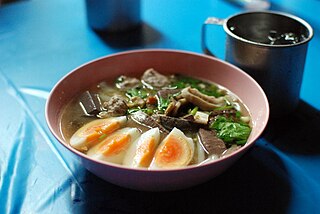
Malaysian cuisine consists of cooking traditions and practices found in Malaysia, and reflects the multi-ethnic makeup of its population. The vast majority of Malaysia's population can roughly be divided among three major ethnic groups: Malays, Chinese and Indians. The remainder consists of the indigenous peoples of Sabah and Sarawak in East Malaysia, the Orang Asli of Peninsular Malaysia, the Peranakan and Eurasian creole communities, as well as a significant number of foreign workers and expatriates.

Nasi lemak is a dish originating in Malay cuisine that consists of fragrant rice cooked in coconut milk and pandan leaf. It is commonly found in Malaysia, where it is considered the national dish. It is also a native dish in neighbouring areas with significant ethnic Malay populations such as Singapore and Southern Thailand. In Indonesia, it can be found in several parts of Sumatra, especially the Malay regions of Riau, Riau Islands and Medan. It is considered an essential dish for a typical Malay-style breakfast. Nasi lemak is featured as a national dish in Malaysian tourism brochures and promotional materials.

Hokkien mee, literally "Fujian noodles", is a series of related Southeast Asian dishes that have their origins in the cuisine of China's Fujian (Hokkien) province.

Singaporean cuisine is derived from several ethnic groups in Singapore and has developed through centuries of political, economic, and social changes in the cosmopolitan city-state.

Malaysian Chinese cuisine is derived from the culinary traditions of Chinese Malaysian immigrants and their descendants, who have adapted or modified their culinary traditions under the influence of Malaysian culture as well as immigration patterns of Chinese to Malaysia. Because the vast majority of Chinese Malaysians are descendants of immigrants from southern China, Malaysian Chinese cuisine is predominantly based on an eclectic repertoire of dishes with roots from Fujian, Cantonese, Hakka and Teochew cuisines.

Noodle soup refers to a variety of soups with noodles and other ingredients served in a light broth. Noodle soup is a common dish across East Asia, Southeast Asia and the Himalayan states of South Asia. Various types of noodles are used, such as rice noodles, wheat noodles and egg noodles.

Chinese Indonesian cuisine is characterized by the mixture of Chinese with local Indonesian style. Chinese Indonesians, mostly descendant of Han ethnic Hokkien and Hakka speakers, brought their legacy of Chinese cuisine, and modified some of the dishes with the addition of Indonesian ingredients, such as kecap manis, palm sugar, peanut sauce, chili, santan and local spices to form a hybrid Chinese-Indonesian cuisine. Some of the dishes and cakes share the same style as in Malaysia and Singapore, known as Nyonya cuisine by the Peranakan.

Fish head curry is a dish in Indonesian, Malaysian and Singaporean cuisines with mixed Indian and Chinese origins. The head of a red snapper is stewed in a Kerala-style curry with assorted vegetables such as okra and eggplants. It is usually served with either rice or bread, or as a shared dish.

Peranakan cuisine or Nyonya cuisine comes from the Peranakans, descendants of early Chinese migrants who settled in Penang, Malacca, Singapore and Indonesia, inter-marrying with local Malays. In Baba Malay, a female Peranakan is known as a nonya, and a male Peranakan is known as a baba. The cuisine combines Chinese, Malay, Javanese, South Indian, and other influences.

Pig's organ soup or chheng-thng (清湯), is a Malaysian and Singaporean soup that is made from pork offal. The dish is a clear soup, served with other optional side dishes as well as rice.

Indian Singaporean cuisine refers to food and beverages produced and consumed in Singapore that are derived, wholly or in part, from South Asian culinary traditions. The great variety of Singapore food includes Indian food, which tends to be Tamil cuisine and especially local Tamil Muslim cuisine, although North Indian food has become more visible recently. Indian dishes have become modified to different degrees, after years of contact with other Singapore cultures, and in response to locally available ingredients as well as changing local tastes. The local forms of Indian food may be seen as localised or even regional variations of Indian food, or in some cases, a form of hybrid Indian-Singaporean cuisine. Popular 'Indian' dishes and elements of Indian cuisine include:

Wenchang chicken is a type of chicken breed and a chicken dish from the Wenchang city area in the island province of Hainan, China.

Duck rice is a Southeast Asian meat dish usually consumed by the Chinese diaspora in Maritime Southeast Asia, made of either braised or roasted duck and plain white rice. The braised duck is usually cooked with yam and shrimps; it can be served simply with plain white rice and a thick dark sauce; side dishes of braised hard-boiled eggs, preserved salted vegetables, or hard beancurd may be added. In addition, Teochew boneless duck rice is a similar, but a more refined dish; due to the slightly tougher texture of duck, the duck is artfully deboned and sliced thinly for the convenience and ease of the diner, allowing the sauces to seep into the meat; Hainanese chicken rice and other similar dishes have followed this style due to the popularity.

The Eurasian cuisine of Singapore and Malaysia is a type of fusion cuisine.

Hainanese chicken rice is a dish of poached chicken and seasoned rice, served with chilli sauce and usually with cucumber garnishes. It was created by immigrants from Hainan in southern China and adapted from the Hainanese dishes of Wenchang chicken and Wenchang chicken rice.

Teochew porridge is a Teochew rice porridge dish often accompanied with various small plates of side dishes. Teochew porridge is served as a banquet of meats, fish egg, and vegetables that is eaten with plain rice porridge. It may be simply prepared plain, or include sweet potatoes. The rice grains, while softened from cooking, are still whole and not in an overly starchy state. Because the porridge is served plain, it is suitable to accompany salty side dishes. The recipe originated in Chaozhou and was later modified by early immigrants prepared in Malaysia and Singapore over the generations to suit local tastes.

Sabahan cuisine is a regional cuisine of Malaysia. As in the rest of Malaysian cuisine, Sabah food is based on staples such as rice with a great variety of other ingredients and different methods of food preparations due to the influence of the state's varied geography and indigenous cultures that were quite distinct from the regional cuisines of the Peninsular Malaysia. Sabah along with its neighbour of Sarawak is famous for their multi-ethnic population.

Ayam buah keluak is a traditional Peranakan dish consisting of chicken (ayam), tamarind gravy and buah keluak nuts. It is normally served with rice. It is also one of the favorite dishes of Singapore's founding Prime Minister, Lee Kuan Yew and his son, Lee Hsien Loong.

Kway jap, also spelt kuay jap is a Teochew noodle soup originating in Chinese cuisine consisting of flat, broad rice sheets (kway) in a soup made with dark soy sauce, served with an assortment of pork cuts including offal, pork belly, intestines, and pig's ears, braised duck meat, various kinds of beancurd, preserved salted vegetables, and braised hard-boiled eggs.


















